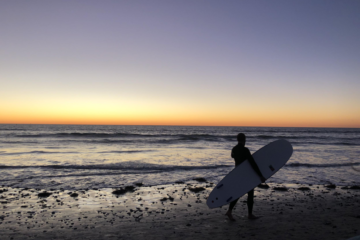Riding the Wave to Economic Growth
Cortland has lived in the South Bay area for almost three decades. I spotted him walking along Highland Avenue. He was tall, with sand still in his hair
“I love this area,” he said. “I’ve lived here for a long time, like pretty much my whole life. I know people don’t like the tourists or the summer rush, but I couldn’t have had a better living experience here. You’re right next to the beach, the surf is good, the community is nice. It’s just a great place.”
Location, location, location. Economic growth of cities and towns is often affected by geography and location, and that’s why it is important to study the factors which determine and maximize economic growth.
One important study, lead by the University of Sydney professor and researcher Sam Willis, has quantified the value of one of these “Natural Amenities.’’

In his study Willis and his team looked at quality surf breaks, and how much they affect the growth of beach towns. To do this they looked at the amount of light pollution of individual cities from 1992-2013. Willis and his team associate more lights with increased economic growth, as lights are associated with new businesses, infrastructure, and a growing community in general. Researchers used a five-point system to rate surf breaks, five being the best and one the worst. This study identified over 5,000 different surf breaks using a verified rating system from an independent global database to help Willis answer the question:
Do places with high quality surf breaks grow faster than those with low quality breaks?
The study found that the cities which had worse breaks grew slower than cities who had 3 and 4-star breaks, based on the idea that an increase in lights visible (via a satellite image) means more growth over time.
So what does all this mean for the South Bay? First, it bodes well for cities like Manhattan Beach and Hermosa Beach. This area can be identified as a consistent two to three-star surf break depending on the time of year and conditions. So, if we use Willis and his team’s thesis and research, this area should be growing faster than a city of similar size and demographic makeup which did not have this natural amenity.
In fact, if we examine Manhattan Beach, the growth over a 20-year period (1990-2010) has increased almost 12 percent, a much higher rate than similar inland cities.
According to the research, each individual break can contribute up to $3 million extra in revenue for the surrounding area. The study highlights surf tourism as a major driver of growth for beach cities like Manhattan and Hermosa, as continuous good breaks only increase the influx of surfers flocking to those beaches.
Good surf can often lead to economic growth, but it doesn’t happen automatically. Communities and cities must promote those beaches to utilize their breaks to the fullest economic potential. This can come from policy, infrastructure, and the culture the local community has toward surfing.
 The infrastructure which can promote great surf breaks can be seen within the South Bay communities. This includes parking lots, public access points, and public bathrooms for beach goers to use, adequate roadways to help locals as well as tourists get to the beach, and businesses to help support the surfing community.
The infrastructure which can promote great surf breaks can be seen within the South Bay communities. This includes parking lots, public access points, and public bathrooms for beach goers to use, adequate roadways to help locals as well as tourists get to the beach, and businesses to help support the surfing community.
While these all help feed the economic growth of the cities as more and more people flock to the beach, policy and the attitude of the locals can effect it as well. If the municipal government of these areas are willing to shape their policy around surf tourism, then they can continue to capitalize on the valuable natural amenity (the three or four star surf break) which drives economic growth. An example of this could be a local government funded Visitor Bureau or allowing surfers certain sections of the beach to surf unobstructed.
Lastly the culture surrounding surfing and the acceptance of tourism by locals can have a profound effect on whether or not a surf breaks attracts patrons. To me, the South Bay community seems to embrace the tourists that the decently good break attracts.
To get a better understanding of the perception from South Bay locals, I recently went around the Manhattan and Hermosa area to ask what people thought about surf tourism, what things can help drive economic growth centered around surfing, and why they thought it was important for their community.
You can hear some of my interviews with local residents Cortland, Jack and Ryan here:
Cortland
Jack
Ryan
Overall, the perception of surfing and tourism is generally positive. Most, like Jack and Ryan, see just how crucial tourism is for their communities in terms of economic growth. While some, like Cortland, dislike the fact that the good spots to surf are always crowded, even he realizes the importance of maintaining an accepting surf culture.
According to Willis, great breaks can increase economic growth, however what he doesn’t discuss in his research is the importance of maximizing those natural amenities by supporting them with favorable policy, infrastructure, and cultural acceptance. All of which, a majority of the South Bay community seems to have adopted.


